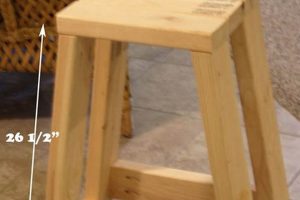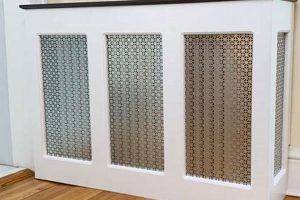Protective window coverings, constructed and installed by the property owner, offer a defense against the damaging effects of severe weather events. These self-made barriers are designed to shield vulnerable entry points from wind-borne debris and pressure fluctuations, mitigating potential structural compromise. As an example, plywood sheets, corrugated metal, or manufactured panels can be adapted for this purpose.
The application of these protective measures delivers several benefits, including cost savings relative to professional installation and customized fit for unique architectural features. Historically, property owners have sought affordable and readily available solutions for weather protection. This approach fosters self-reliance and immediate responsiveness to impending weather threats, contributing to enhanced community resilience.
The subsequent sections detail crucial considerations for material selection, construction methodologies, and installation techniques applicable to safeguarding properties against inclement weather. These practical guidelines promote effective implementation of self-reliant protective strategies.
Protective Barrier Construction
This section outlines critical guidance for the effective creation of window and door defenses against adverse weather conditions. Adherence to these recommendations will improve the structural integrity and protective capability of self-constructed storm protection.
Tip 1: Material Selection. Prioritize impact-resistant materials such as marine-grade plywood (minimum 5/8-inch thickness) or code-approved polycarbonate sheets. These materials offer superior protection against wind-borne projectiles compared to standard plywood.
Tip 2: Accurate Measurement. Precisely measure the dimensions of each window and door opening. Add at least 4 inches to both the width and height measurements to ensure adequate overlap and secure attachment to the surrounding structure.
Tip 3: Secure Attachment. Employ robust fastening methods, such as anchor bolts or structural screws, to securely attach the protective barriers to the building frame. Ensure fasteners are appropriately sized and spaced according to the chosen material and building codes.
Tip 4: Pre-Drilling. Before installing fasteners, pre-drill pilot holes in both the protective barrier and the building frame. This prevents splitting or cracking of the materials, ensuring a stronger and more durable connection.
Tip 5: Labeling and Storage. Clearly label each protective barrier with its corresponding window or door opening. Store the barriers in a dry, accessible location to facilitate rapid deployment when needed.
Tip 6: Regular Inspection. Periodically inspect the protective barriers for signs of damage, such as cracks, delamination, or corrosion. Replace damaged materials promptly to maintain their effectiveness.
Tip 7: Code Compliance. Research and adhere to local building codes and regulations regarding storm protection measures. This ensures that the protective barriers meet minimum safety standards and are properly installed.
Implementing these guidelines contributes to a more secure and resilient property against severe weather. Proper planning and execution significantly improve the effectiveness of self-constructed protective measures.
The following sections address specific construction techniques and address potential challenges encountered during implementation.
1. Material Impact Resistance
Material impact resistance is a cornerstone of effective storm protection. The primary function of owner-constructed weather protection is to shield vulnerable entry points from projectiles propelled by high winds. Selection of materials lacking sufficient impact resistance renders the protective measure ineffective, potentially leading to structural damage and safety risks. The cause-and-effect relationship is direct: inadequate material strength results in penetration by debris, negating the intended protective function. As an example, using standard plywood, as opposed to marine-grade or impact-rated polycarbonate, offers significantly less protection against flying objects such as tree branches or construction materials. This understanding is of practical significance because it directly influences material selection and, consequently, the overall efficacy of owner-implemented safety measures.
The degree of impact resistance required is often determined by geographic location and prevailing weather patterns. Coastal regions prone to hurricanes necessitate more robust materials compared to inland areas with less severe weather risks. Furthermore, building codes in certain jurisdictions may mandate specific impact resistance standards for owner-created or commercially available storm protection systems. Selecting materials compliant with these codes ensures adherence to minimum safety requirements and reduces the potential for property damage. An area constantly getting hammered by hurricanes will need aluminum materials that can withstand winds up to 200mph.
In summary, material impact resistance is an indispensable characteristic of effective storm protection. Choosing appropriate materials, based on anticipated weather conditions and local building codes, is paramount for ensuring the safety and security of properties during severe weather events. Failing to prioritize this aspect undermines the entire premise of self-constructed storm protection and could lead to preventable damage and injury.
2. Secure Mounting Integrity
Secure mounting integrity represents a critical factor in the effectiveness of owner-constructed weather protection systems. The protective barrier’s ability to withstand extreme wind pressures depends directly on the strength and reliability of its attachment to the building’s structure. A compromised mounting system negates the protective benefits of the materials, potentially transforming the barrier into a projectile, causing further damage. Consider the scenario where a properly constructed plywood shield, attached with inadequate screws or improperly spaced anchors, detaches during a high-wind event; the shield’s failure renders the window vulnerable and creates an additional hazard from the dislodged material. Therefore, a thorough understanding and meticulous execution of secure mounting techniques are paramount.
Several factors contribute to secure mounting integrity. These include the selection of appropriate fasteners, such as anchor bolts or structural screws, designed for the specific substrate (e.g., concrete, wood framing). Proper spacing of fasteners is also crucial, as insufficient spacing can create weak points. Adherence to local building codes concerning fastener types, spacing, and embedment depths is essential for ensuring compliance and structural integrity. Further, the correct installation technique,
including pre-drilling pilot holes to prevent splitting or cracking, significantly affects the overall strength of the connection. For example, using the wrong screws can easily sheer and snap in hurricane force winds.
In conclusion, secure mounting integrity is not merely a component of owner-constructed weather protection; it is a prerequisite for its success. Failure to adequately secure the protective barrier to the building can render the entire system ineffective and create additional hazards. Proper planning, material selection, and adherence to installation best practices are essential for achieving the required level of secure mounting integrity, thereby maximizing the protective benefits during severe weather events.
3. Precise Dimensional Accuracy
Precise dimensional accuracy is a cornerstone of effective, owner-constructed weather protection. Inadequate attention to accurate measurements and fabrication tolerances can significantly compromise the protective capabilities of the system. This element directly influences the ability of the protective barrier to effectively cover and shield the intended openings.
- Preventing Wind and Water Intrusion
Accurate dimensions ensure a tight fit between the protective barrier and the window or door frame. Gaps created by inaccurate measurements provide pathways for wind and water to infiltrate the structure, potentially causing significant damage. For example, even a small gap around the perimeter of a protective panel can allow wind-driven rain to penetrate, leading to water damage and mold growth inside the building.
- Ensuring Structural Integrity
Precise dimensions contribute to the overall structural integrity of the protective barrier. Ill-fitting panels can be subjected to uneven stress distribution during high-wind events, potentially leading to panel failure. A well-fitted panel distributes wind loads more evenly, enhancing its ability to withstand extreme pressures. The shape is also very important, such as a rectangle.
- Facilitating Secure Mounting
Accurate dimensions are crucial for facilitating secure mounting of the protective barrier. If the panel is too small, there may be insufficient overlap with the surrounding frame, compromising the effectiveness of the mounting system. Conversely, if the panel is too large, it may be difficult to install and secure properly, potentially leading to instability. It also need professional install to maintain the secure.
- Optimizing Material Usage and Cost
Precise measurements minimize material waste and associated costs. Inaccurate measurements can result in the need to re-cut or remake panels, increasing material consumption and labor costs. Accurate planning and execution optimize material usage, reducing overall project expenses. This will cause the business not wasting money.
These interconnected facets underscore the critical importance of precise dimensional accuracy in the construction of owner-provided weather protection. Prioritizing accurate measurements and fabrication processes ensures a snug, structurally sound, and cost-effective system that effectively safeguards properties against severe weather events. Conversely, neglecting these considerations compromises the system’s effectiveness and increases the risk of damage.
4. Weather Sealing Effectiveness
Weather sealing effectiveness constitutes a crucial element in the overall performance of self-installed storm protection. It directly impacts the ability of the system to mitigate water intrusion and reduce wind infiltration, thereby minimizing potential damage to the protected structure.
- Material Selection for Seal Integrity
The selection of appropriate materials is paramount for effective weather sealing. Compressible materials, such as closed-cell foam or weather stripping, should be incorporated between the protective barrier and the building frame. These materials create a tight seal, preventing water penetration and reducing air leakage. For instance, applying a strip of closed-cell foam along the perimeter of a plywood panel before installation can significantly enhance its weather sealing capability. Choosing appropriate materials can significantly improve sealing.
- Seam and Joint Treatment
Proper treatment of seams and joints is essential to prevent water intrusion. Overlapping panels or joints should be sealed with waterproof caulk or sealant to create a continuous barrier. Additionally, the use of flashing around the perimeter of the storm protection system can further enhance weather sealing by diverting water away from vulnerable areas. An example includes caulking the seams on aluminum materials to help prevent rusting and leaks.
- Minimizing Air Infiltration
Effective weather sealing minimizes air infiltration, reducing the potential for wind damage and energy loss. Air leakage can create pressure differentials that exacerbate wind loads on the structure, potentially leading to structural damage. Properly sealed storm protection systems reduce air infiltration, mitigating these risks and improving energy efficiency. The less air that can get in the more effective the sealant is.
- Regular Inspection and Maintenance
Weather sealing effectiveness requires regular inspection and maintenance to ensure its continued performance. Sealants and weather stripping can degrade over time due to exposure to the elements, requiring periodic replacement. Regularly inspecting the storm protection system and addressing any signs of damage or deterioration is essential for maintaining its weather sealing capabilities. Checking after a storm and fixing any damage is crucial to continue its success.
These elements underscore the significance of prioritizing weather sealing effectiveness in the design and installation of self-provided storm protection. By employing appropriate materials, techniques, and maintenance practices, property owners can significantly enhance the protective capabilities of these systems, mitigating water damage, reducing wind infiltration, and improving overall structural resilience.
5. Building Code Adherence
Building code adherence constitutes a critical aspect of owner-constructed weather protection, influencing safety, structural integrity, and legal compliance. Failure to comply with relevant building codes may result in ineffective protection, property damage, and potential liability.
- Wind Load Requirements
Building codes specify minimum wind load resistance standards for storm protection systems. These standards dictate the level of force the protective barriers must withstand during high-wind events. Non-compliance with wind load requirements can lead to system failure, rendering it ineffective in protecting the structure. As an example, Florida Building Code establishes specific wind load criteria for different coastal zones, dictating the necessary resistance levels for weather protection.
- Material Spe
cificationsBuilding codes often prescribe acceptable materials for storm protection, including minimum thickness, impact resistance, and durability standards. Deviation from these material specifications can compromise the system’s ability to withstand wind-borne debris and extreme pressures. An example is the requirement for using marine-grade plywood or impact-resistant polycarbonate sheets in areas prone to hurricanes.
- Attachment Methods and Fastener Requirements
Building codes outline approved attachment methods and fastener specifications for securing storm protection systems to the building structure. These regulations dictate the type, size, spacing, and embedment depth of fasteners necessary to ensure a secure and reliable connection. Non-compliance with attachment requirements can result in system detachment during high-wind events. For instance, codes may specify the use of anchor bolts with a minimum diameter and embedment depth for attaching weather protection to concrete walls.
- Permitting and Inspection Processes
Some jurisdictions require permits and inspections for owner-provided weather protection systems. These processes ensure that the system complies with relevant building codes and safety standards. Failure to obtain necessary permits or undergo required inspections can result in fines or legal action. For example, many municipalities require homeowners to submit construction plans and obtain a permit before installing weather protection, followed by an inspection to verify code compliance.
These multifaceted considerations highlight the imperative of building code adherence in the construction of owner-installed weather protection. Compliance with relevant codes ensures that the system meets minimum safety standards, provides adequate protection against severe weather events, and avoids potential legal repercussions. Neglecting these regulations undermines the efficacy of the protective measures and increases the risk of damage and liability.
Frequently Asked Questions
This section addresses common inquiries regarding self-installed storm protection measures. The aim is to clarify misconceptions and provide essential information for informed decision-making.
Question 1: What constitutes acceptable material for owner-fabricated window defense?
Acceptable materials include marine-grade plywood (minimum 5/8 inch thickness), impact-resistant polycarbonate sheets, and aluminum panels meeting specific wind load requirements. Material selection should align with local building codes and anticipated weather conditions. Standard plywood typically does not provide adequate protection.
Question 2: How is proper attachment of these systems ensured?
Secure attachment necessitates the use of appropriately sized anchor bolts or structural screws, spaced according to building code specifications. Pre-drilling pilot holes prevents splitting and ensures a stronger connection. Consider the substrate material (e.g., concrete, wood framing) when selecting fasteners.
Question 3: Are there specific dimensional tolerances to observe during construction?
Precise dimensional accuracy is critical. Panels should overlap the window or door frame by at least 4 inches on all sides to ensure adequate coverage and secure mounting. Minimize gaps to prevent wind and water intrusion.
Question 4: How can water intrusion be effectively minimized?
Effective weather sealing involves incorporating compressible materials, such as closed-cell foam or weather stripping, between the panel and the frame. Sealing seams and joints with waterproof caulk or sealant creates a continuous barrier. Flashings can divert water away from vulnerable areas.
Question 5: Is adherence to local building codes mandatory?
Strict adherence to local building codes is non-negotiable. Codes specify wind load requirements, material specifications, and attachment methods. Failure to comply may result in ineffective protection, property damage, and legal consequences. Permits and inspections may be required.
Question 6: What maintenance is required to maintain the protective measures?
Regular inspection is imperative. Check for signs of damage, such as cracks, delamination, or corrosion. Replace damaged materials promptly. Inspect and replace sealant or weather stripping as needed to maintain weather sealing effectiveness.
The information provided herein aims to address frequently encountered inquiries. Proper implementation and ongoing maintenance are essential for ensuring the long-term effectiveness of these systems.
The following section presents a comparative analysis of different material options, highlighting their relative strengths and weaknesses.
DIY Storm Shutters
This exploration has elucidated the multifaceted considerations surrounding owner-constructed window defenses. Material selection, mounting integrity, dimensional precision, weather sealing, and code compliance have been presented as essential elements in creating effective protective barriers. The information detailed herein underscores the importance of meticulous planning and execution.
Implementing these strategies represents a proactive approach to safeguarding properties against the destructive forces of severe weather. Careful consideration of the factors outlined will contribute to enhanced resilience and reduced risk of damage. Prioritizing these measures is crucial for responsible property ownership in vulnerable regions.







